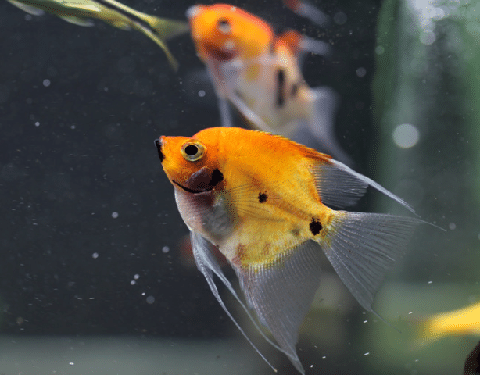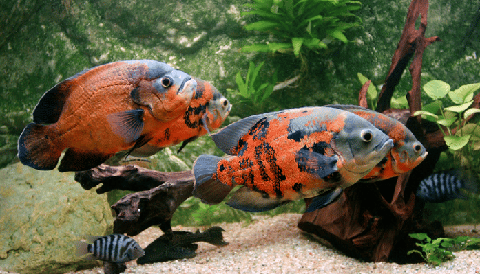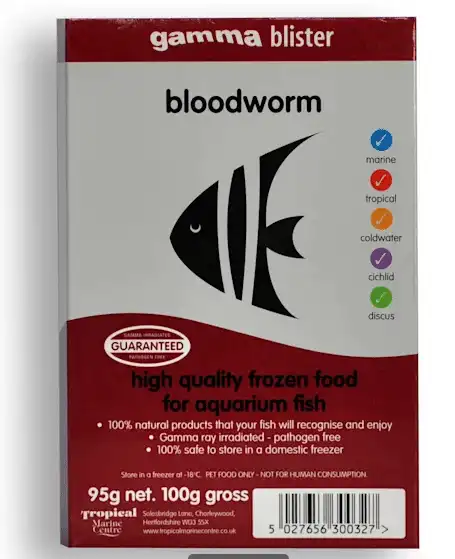Thank you for visiting! By the way… any links on this page that lead to products on Amazon and other stores/partners are affiliate links Aquarium Store Depot earns a commission if you make a purchase.
This guide is here to help aquarium enthusiasts pick the perfect fish species, the African rope fish! We’ll explain its unique characteristics such as eel-like features, snake tendencies and other qualities that make it stand out. You can also learn about this freshwater creature’s natural habitat plus how to set up the right tank environment and find appropriate companions for your new pet.
Key Takeaways
- The African rope fish is an easy going fish that will get along with most fish in an aquarium
- They will eat small fish an may get bullied by other fish that are aggressive
- They grow to 18 inches in aquariums and 3 feet in the wild
- They can live in both freshwater and brackish water environments
Species Overview
| Scientific Name | Erpetoichthys calabaricus |
| Common Names | Rope Fish, Reed Fish, Snake Fish |
| Family | Polypteridae |
| Origin | West and Central Africa |
| Diet | Carnivorous |
| Care Difficulty | Intermediate |
| Activity | Nocturnal |
| Life Expectancy | 10 – 15 years |
| Temperament | Peaceful (Will eat smaller fish) |
| Tank Level | Bottom Dweller |
| Minimum Tank Size | 55 gallons (208 liters) |
| Temperature Range | 72-82°F (22-28°C) |
| Water Hardness | 5-20 dKH (degrees of Carbonate Hardness) |
| pH Range | 6.2 – 7.8 |
| Filtration/Water Flow | Moderate |
| Water Type | Freshwater or Brackish Water |
| Breeding | N/A |
| Difficulty to Breed | N/A |
| Compatibility | Community tank with appropriate sized fish |
| OK, for Planted Tanks? | Yes |
Introduction
Coming from the rivers of West and Central Africa, Erpetoichthys calabaricus – otherwise known as African rope fish – make for a unique freshwater species with long eel-like bodies. Despite looking like snakes, these animals are quite peaceful, making them perfect community aquarium candidates if given suitable tank mates.
So let’s explore what it takes to care for rope fish correctly and why they have become so popular aquarium fish in the aquarium trade.
Natural Habitat And Distribution
Rope fish, also known as snake or reed fish, are native to rivers in countries such as the West and Central African regions of Cameroon and Nigeria1. To achieve a comfortable environment for these creatures in an aquarium, it’s essential that the water quality remain consistent like their natural habitat with little oxygen flow plus adequate hiding places made available for them to feel secure, reducing stress levels and leading to healthier, happier rope fish!
Creating tank conditions resembling those found naturally is a key factor when setting up a suitable home so they can thrive optimally.
Appearance

The rope fish is distinguished by its long, cylindrical form, which features diamond-shaped scales and the lack or reduction of fins aside from small pectoral fins near their heads. Like with many eel like fish, it is difficult to determine between male and female rope fish because they appear so alike. Some think that males may have more rays on their dorsal fin than females, though it proves tough for accurate counting. In any case, these exotic looking creatures with make a great addition to community aquariums due to their very distinct appearance and easygoing nature
Size And Growth
Rope fish can reach up to 2 feet in length, which means they need a suitable sized tank. When providing them with an environment suitable for their needs a tank of at least 50 gallons is best for housing a rope fish.
Each additional ropefish requires 10-15 extra gallons. As the rope fish grow bigger and longer over time, other species inside the same enclosure have to increase in size, too, or else risk becoming food for your ever-growing pets. To ensure health and happiness, you need to make sure there’s enough space available for all residents within the tank!
Rope Fish Care Guide
When it comes to looking after rope fish, creating the perfect habitat that replicates their natural environment is key. We will discuss how best to do this with regard to substrate, decorations, and water parameters in order for your rope fish’s health and happiness.
Substrate And Decorations
When setting up a tank for rope fish, it is important to mimic their natural habitat and provide a sandy substrate. This allows them to feel comfortable while exploring in the familiar environment they are accustomed to. To be able to do so, add character to their setup.
Natural sand is excellent for bottom feeder fish to forage around in.
Hiding places such as rocks, driftwood, or caves can be incorporated along with plants like Java Ferns and Amazon Swords which not only give an aesthetically pleasing view but also offer additional cover for your Rope Fish.
Water Parameters And Filtration
While this fish is a hardy fish, having consistent ideal water parameters will help them thrive. These levels include a pH level between 6.0 and 7.5, as well as a hardness level of up to 20 dKH. In order to provide the best environment possible, it’s important that you maintain an aquarium temperature range between 72°F–75°F (22-24°C). Ammonia and Nitrite levels should be maintained at 0 PPM. Nitrates should say below 40 PPM.
The right filtration system is essential in keeping high standards when it comes to maintaining optimal water quality and clarity – we recommend using canister filters which are particularly adept at removing debris & organic waste from your tank while also sustaining suitable conditions day after day for these aquatic creatures.
Diet And Nutrition
When it comes to diet, rope fish have a carnivorous palate that consists of small crustaceans, insects, worms, and other tiny species. Being nocturnal creatures reliant on their sense of smell for food in the wild, meaty foods such as bloodworms and insect larvae should be given regularly when kept captive. As they get older, food like night crawlers are ideal for them.
Frozen bloods are a great source of protein and a fish source fish naturally respond to. Very filling and works for just about any fish
Adult Rope Fish are best fed once every 24 hours, while juvenile rope fish require twice daily meals before turning off tank lights at night for optimal nourishment.
Behavior
When it comes to Rope Fish behavior, they have a peaceful temperament and usually get along well with other non-aggressive species of aquatic life. The Rope Fish possess the remarkable ability to live in oxygen-deficient surroundings, which leads them, from time to time, to come up close to the water’s surface for air. This is a major problem in captivity as your Rope Fish is known as escape artists. You will want to secure your tank with a proper lid to keep them from getting out.
Establishing Compatible Tank Mates
When it comes to tankmates for rope fish, selecting the proper ones is essential to guarantee a peaceful and serene habitat. We’ll go over some of the best compatible choices as well as those which should be avoided when considering what other freshwater species are suitable companions for your Rope Fish.
Good Tank Mates

When it comes to rope fish tank mates, peaceful species that are not very small fish are great choices. Some good options include:
- Dwarf gourami
- Honey gourami
- Pictus catfish
- Siamese algae eater
- Barbs
- Loaches
- Angelfish
- Freshwater sharks
When keeping rope fish one must consider its increasing size over time which may cause aggression towards smaller fishes thus, proper attention should be given by providing adequate space accordingly without endangering them from being an intended mealtime snack!
Bad Tank Mates

It’s essential to be selective about the tank mates of rope fish. Aggressive species, such as the following below, should be avoided:
- African cichlids
- Oscars
- Jack Dempsey
- Arowanas
These types of freshwater fish could generate stress for your ropefish or inflict damage on them, which will make their habitat an unhealthy one. Here are small fish and other peaceful species that may end up as snacks:
- Freshwater shrimp
- Aquarium snails
- Minnows
- Other small fish like Rasboras
Breeding Challenges And Tips
If you’re determined to breed rope fish in captivity, there are certain steps that may improve your chances. Increasing the water temperature slightly and adding taller plants can help create a suitable habitat for breeding. After around 70 hours, when juveniles hatch, it is important to move them away from adult rope fish since they might get eaten otherwise. Even though this kind of endeavor can be demanding, having successful results will make aquarium enthusiasts very pleased with their achievement!
Health Concerns And Disease Prevention
The health of rope fish can be jeopardized by diseases like:
To ensure a healthy environment for the species, it is essential to monitor their condition and regularly check water parameters that imitate their natural habitat. Good quality water helps maintain overall stability for your freshwater fish’s wellbeing, so make sure you keep an optimum balance in terms of temperature and other variables such as oxygen content etc.
Frequently Asked Questions
Are rope fish hard to take care of?
Maintaining rope fish does not need to be complicated. The tank should provide enough space and stability in order for the species to thrive, while also selecting suitable companions is important. All of this combined makes it great. A simple process when taking care of them. They are considered one of the hardier varieties that can adapt easily within various types of tanks provided their habitat stays consistent.
Overall, properly looking after your rope fish doesn’t have too many complexities as long as essential aspects such as choosing compatible tank mates and keeping environmental conditions relatively similar remain intact.
How big of a tank do rope fish need?
If you are planning on having multiple rope fish in a single tank, make sure to increase the capacity by 10-15 gallons for each additional one. This way, your creatures will have plenty of space to move and grow happily inside their 50 gallon or more aquarium. Keeping them safe with sufficient swimming room is essential if you want healthy happy pet fishes!
What is fish rope?
Fish rope is a must-have for fishermen as it can be used to tether the catch and also serves other fishing needs. Constructed of nylon, polypropylene or cotton depending on requirement, this strong material comes in various sizes and lengths suitable for any angler’s need. It has impressive durability due to its resistance to abrasion and UV rays making it dependable gear when heading out into the sea.
Do rope fish need sand or gravel?
To ensure the safety of rope fish, their habitat should mimic a natural one with soft substrates such as sand or coral sand. This way they won’t be hurt by sharp edges and can still enjoy the environment that resembles their native home without any issues.
Are rope fish hard to take care of?
Rope fish need a large tank for their eventual full size and require precise monitoring of water temperature in order to remain healthy. Maintaining this environment isn’t particularly difficult, however. Taking proper care is key when it comes to keeping rope fish happy and well-adjusted.
Do rope fish need sand or gravel?
To ensure the safety of rope fish, their habitat should mimic a natural one with soft substrates such as sand or coral sand. This way they won’t be hurt by sharp edges and can still enjoy the environment that resembles their native home without any issues.
Are rope fish hard to take care of?
Rope fish need a large tank for their eventual full size and require precise monitoring of water temperature in order to remain healthy. Maintaining this environment isn’t particularly difficult, however. Taking proper care is key when it comes to keeping rope fish happy and well-adjusted.
Summary
With an engaging presence and tranquil disposition combined with fantastic aesthetic qualities, these creatures become truly remarkable aquatic companions – it’s no wonder why people find caring for African ropes such a rewarding pursuit! So if you’re ready to begin your journey as an aquarist specializing in ropefish care be sure not to forget any helpful tips from here!
- About the Author
- Latest Posts
I’m thrilled that you found Aquarium Store Depot! Here you’ll find information on fish, aquariums, and all things aquatics related. I’m a hobbyist (being doing this since I was 11) and here to help other hobbyists thrive with their aquariums! I adhere to a high quality Editorial Process and Review products with real life field usage and practical analysis.







